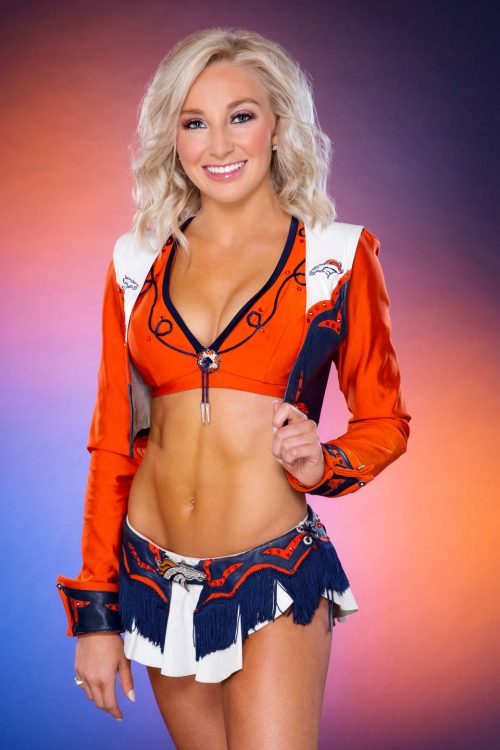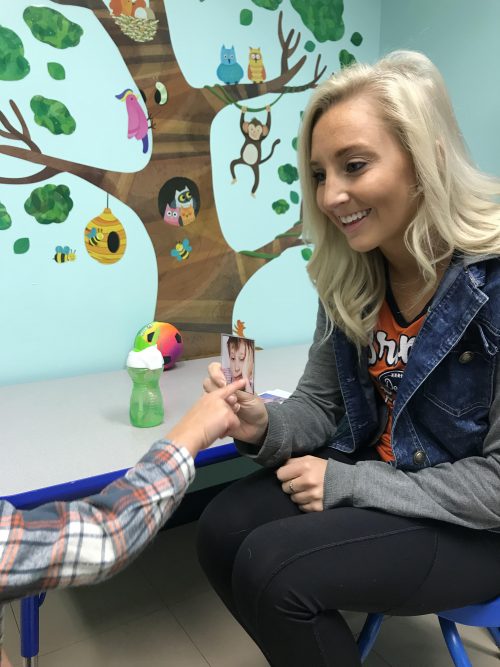Science Cheerleader Hilary here to introduce you to 4th year veteran of the Denver Broncos cheerleaders McKenna! McKenna has a Bachelor’s degree in Speech, Language, and Hearing Sciences and is working towards a Master’s degree in Special Education with an emphasis on Applied Behavioral Analysis. Read below to learn how the confidence McKenna learned from being a cheerleader helps her make young children more confident through her work as a Behavioral Therapist.

What turned you on to STEM and when?
I have always been drawn to science. My science courses in school always “clicked” the most for me, and I was always intrigued and engaged during class. I can’t say there was a single person who specifically influenced my desire to be involved in STEM; rather, it was the many female science teachers that I had throughout the course of my education who broke the stereotypes of women in science. My undergraduate degree really connected my passion for helping people with special needs and science. I could look at different challenges, for example hearing loss, and examine the anatomy of the ear and the conversion of sound waves and calculate decibel levels for hearing devices for different hearing ranges. I believe that is the point of STEM, to be able to apply STEM concepts to real-life situations and create solutions.
Why did you try out to be a cheerleader?
I have been dancing since I could walk. Dance was always a constant in my life growing up. It was a place where I could express myself and create tight-knit friendships. Being a Colorado native, I have always admired the Denver Broncos Cheerleaders. I had a lot of interactions with cheerleaders and was always impressed by their poise and charisma. There was something about them that drew me in and I knew I wanted to be a part of that special something. When I was finally old enough to try out, I knew everything the Denver Broncos Organization had to offer, from outstanding community outreach and community-oriented initiatives to the phenomenal, genuine cheerleaders and the family-like atmosphere. It was these qualities that made me want to try out and be a part of the legacy that is the Denver Broncos Cheerleaders.

Please describe what you do in your science career on a daily basis.
For the last three and a half years I worked as a Behavioral Therapist doing Applied Behavioral Analysis focusing on kids diagnosed with Autism Spectrum Disorder. Therapy is play-based because that is how kids learn best: through play. Each therapy session would be focused on the child as an individual and would have goals written specifically to help that child meet their needs and gain knowledge and functional skills. A lot of therapy focused on producing speech. There is a lot of science and anatomy behind producing a word: how the air is pushed out of your lungs, how your vocal chords vibrate at different frequencies to produce different sounds, the placement of your tongue and teeth in your mouth to produce different sounds, and more. What this might look like would be finding a toy or maybe a snack that the child really wants and helping them mimic a sound I’m making to ask for the item, even if it’s just the first sound of the word, to shape the whole word later. The ultimate goal of Behavioral Therapy and Applied Behavioral Analysis is to help a child by giving them tools to be able to be more successful in life.
What does it mean for you to be practicing in STEM?
Practicing in STEM is empowering. There are so many different ways to be a part of STEM, but you always have the ability to make a difference. I love that the STEM field is always growing and changing. It keeps those involved continuously setting new goals and striving for new advances in their field. I also love that it allows you to be creative while solving problems. By using my background and knowledge in science I have the ability to impact the lives of our youth and create a better future for not only them, but the lives of those they touch.
How do the qualities that make you a great cheerleader benefit you in your STEM career?
Being a cheerleader has taught me to have confidence in myself and my abilities. It’s ok to put yourself out there and show the world your talent, passion, and heart. This crosses over to my career, because it takes confidence to be able to present new ideas and stand up for what you believe will be successful or innovative. It allows me to show my passion for what I do and be proud of my talents in the field. Lastly, it allows me to put my whole heart into my career and the people I am involved with.
There are stereotypes about cheerleaders in our society that make it seem unlikely that a cheerleader could be a Behavioral Therapist. Obviously, these stereotypes are untrue, and you are a great example of that. How do you feel about breaking down negative stereotypes about cheerleaders?
I am so proud of the women in the Denver Broncos organization who fight these stereotypes every day and I jump at any opportunity to expand on their incredible careers. I feel so honored to be able to be a part of this group of women breaking down those stereotypes and shining a light on what women are capable of.
Best cheerleading experience?
The Denver Broncos are very passionate about our military. I have had the opportunity to be a part of two military tours with the Denver Broncos to bring a little piece of home and show our love and support for our service men and women overseas. I was able to travel to South Korea and all over Germany for these life changing experiences.
Best science-related experience?
I absolutely love whenever I visit Children’s Hospital and have the opportunity to see all of the new and innovative technology being used to not only increase patient health but to create a better patient experience.
What advice would you give your 12-year-old self?
I would tell myself to keep pursuing the things that intrigue and excite you and never be afraid to show confidence in your knowledge and your abilities.
What’s one thing people might find especially surprising about you?
I have never broken a bone!
